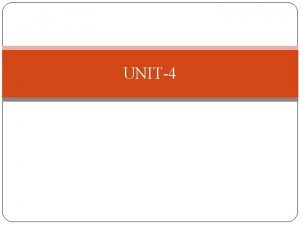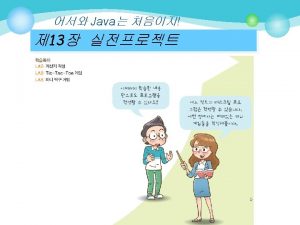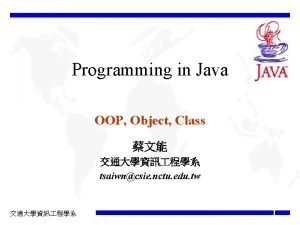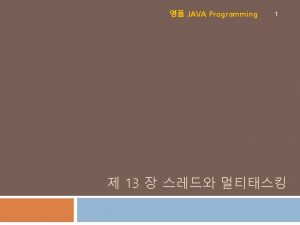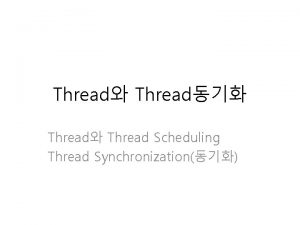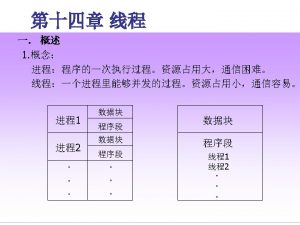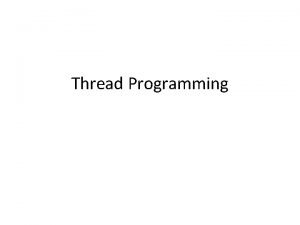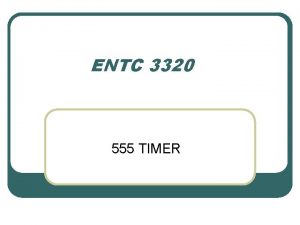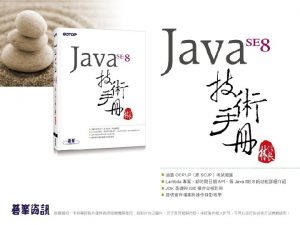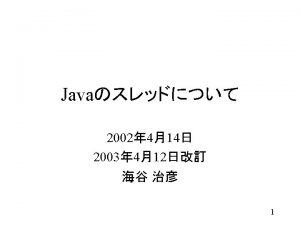Thread 1 Timer Thread class Timer Thread extends

































![집계판 예제 public class Synchronized. Ex { public static void main(String [] args) { 집계판 예제 public class Synchronized. Ex { public static void main(String [] args) {](https://slidetodoc.com/presentation_image/31a4f321b4b3777982e3a66caa937da7/image-34.jpg)







![테스트 클래스 public class Producer. Consumer. Test { public static void main(String[] args) { 테스트 클래스 public class Producer. Consumer. Test { public static void main(String[] args) {](https://slidetodoc.com/presentation_image/31a4f321b4b3777982e3a66caa937da7/image-42.jpg)








- Slides: 50












* Thread를 상속받아 1초 단위로 초 시간을 출력하는 Timer. Thread 스레드 작성 class Timer. Thread extends Thread { int n = 0; public void run() { while(true) { // 무한루프를 실행한다. System. out. println(n); n++; try { 스레드 클래스 정의 스레드 코드 작성 1초에 한 번씩 n을 증가시켜 콘솔에 출력한다. sleep(1000); //1초 동안 잠을 잔 후 깨어난다. } } catch(Interrupted. Exception e){return; } public class Test. Thread { public static void main(String [] args) { Timer. Thread th = new Timer. Thread(); th. start(); } } 스레드 객체 생성 스레드 시작 main() 스레드 th JVM main 스레드의 스 레드 정보 Timer. Thread 스레드 run() {. . . } Timer. Thread 의 스레드 정보 0 1 2 3 4

예제 13 -1 : Thread를 상속받아 1초 단위의 타이머 만들기 import java. awt. *; import javax. swing. *; class Timer. Thread extends Thread { JLabel timer. Label; public Timer. Thread(JLabel timer. Label) { this. timer. Label = timer. Label; } public void run() { int n=0; } } while(true) { timer. Label. set. Text(Integer. to. String(n)); n++; try { Thread. sleep(1000); } catch(Interrupted. Exception e) { return; } } public class Thread. Timer. Ex extends JFrame { public Thread. Timer. Ex() { set. Title(“Thread. Timer. Ex 예제”); set. Default. Close. Operation(JFrame. EXIT_ON_CLOSE); Container c = get. Content. Pane(); c. set. Layout(new Flow. Layout()); JLabel timer. Label = new JLabel(); timer. Label. set. Font(new Font(“Gothic“, Font. ITALIC, 80)); Timer. Thread th = new Timer. Thread(timer. Label); c. add(timer. Label); set. Size(300, 150); set. Visible(true); } } th. start(); public static void main(String[] args) { new Thread. Timer. Ex(); }



*Runnable 인터페이스를 상속받아 1초 단위로 초 시간을 출력하는 스레드 작성 Runnable 을 클래스로 구현 스레드 코드 작성 1초에 한 번씩 n을 증가시켜 콘솔에 출력한다. class Timer. Runnable implements Runnable { int n = 0; public void run() { while(true) { // 무한루프를 실행한다. System. out. println(n); n++; try { Thread. sleep(1000); // 1초 동안 잠을 잔 후 깨어난다. } 스레드 객체 생성 스레드 시작 } } } catch(Interrupted. Exception e) { return; } public class Test. Runnable { public static void main(String [] args) { Thread th = new Thread(new Timer. Runnable()); th. start(); } } main() 스레드 th 16 JVM main 스레드의 스 레드 정보 Thread 스레드 run() {. . . } Thread 의 스레드 정보 0 1 2 3 4

예제 13 -2 : Runnable인터페이스를 구현하여 1초 단위 타이머 만들기 import java. awt. *; import javax. swing. *; class Timer. Runnable implements Runnable { JLabel timer. Label; } public Timer. Runnable(JLabel timer. Label) { this. timer. Label = timer. Label; } public void run() { int n=0; while(true) { timer. Label. set. Text(Integer. to. String(n)); n++; try { Thread. sleep(1000); } catch(Interrupted. Exception e) { return; } } } public class Runnable. Timer. Ex extends JFrame { public Runnable. Timer. Ex() { set. Title(“Runnable. Timer. Ex 예제”); set. Default. Close. Operation(JFrame. EXIT_ON_CLOSE); Container c = get. Content. Pane(); c. set. Layout(new Flow. Layout()); JLabel timer. Label = new JLabel(); timer. Label. set. Font(new Font(“Gothic“, Font. ITALIC, 80)); } } Timer. Runnable runnable = new imer. Runnable(timer. Label); Thread th = new Thread(runnable); c. add(timer. Label); set. Size(300, 150); set. Visible(true); th. start(); public static void main(String[] args) { new Runnable. Timer. Ex(); }


예제 13 -3 : 깜박이는 문자열을가진 레 이블 컴포넌트 만들기 import java. awt. *; import javax. swing. *; class Flickering. Label extends JLabel implements Runnable{ public Flickering. Label(String text) { super(text); // JLabel 생성자 호출 set. Opaque(true); // 배경색 변경이 가능하도록 설정 } } public class Flickering. Label. Ex extends JFrame { public Flickering. Label. Ex() { set. Title(“Flickering. Label. Ex 예제”); set. Default. Close. Operation(JFrame. EXIT_ON_CLOSE); Container c = get. Content. Pane(); c. set. Layout(new Flow. Layout()); // 깜박이는 레이블 생성 Flickering. Label f. Label = new Flickering. Label(“깜박”); Thread th = new Thread(this); th. start(); public void run() { int n=0; while(true) { if(n == 0) set. Background(Color. YELLOW); else set. Background(Color. GREEN); if(n == 0) n = 1; else n = 0; try { Thread. sleep(500); // 0. 5초 동안 잠을 잔다. } catch(Interrupted. Exception e) { return; } } } // 깜박이지 않는 레이블 생성 JLabel label = new JLabel(“안깜박“); // 깜박이는 레이블 생성 Flickering. Label f. Label 2 = new Flickering. Label(“여기도 깜박 ”); c. add(f. Label); c. add(label); c. add(f. Label 2); } } set. Size(300, 150); set. Visible(true); public static void main(String[] args) { new Flickering. Label. Ex(); }




스레드 상태와 생명 주기 thread. A = new Thread() 스레드 상태 6 가지 • NEW • RUNNABLE • WAITING • TIMED_WAITING • BLOCK • TERMINATED NEW(탄생) start() 타임아웃 I/O작업 완료 RUNNABLE (준비) yield() run() 또는 JVM에 의해 스케쥴링될 때 RUNNABLE (running, 실행중) Object. wait() WAITING(대기 ) I/O작업 요청 스레드 종료 BLOCK(봉쇄) sleep() thread. B TIMED_WAITING (시간 대기) TERMINATED (종료) Object. notify(); Object. notify. All(); ** wait(), notify. All()은 Thread의 메소드가 아니며 Object의 메소드임


main()은 자바의 main 스레드 • main() 메소드 – JVM에 의해 자동으로 스레드화 – 자바 스레드 : main 스레드 – main() 함수가 스레드 코드로 사용 public class Thread. Main. Ex { public static void main(String [] args) { long id = Thread. current. Thread(). get. Id(); String name = Thread. current. Thread(). get. Name(); int priority = Thread. current. Thread(). get. Priority(); Thread. State s = Thread. current. Thread(). get. State(); } } 현재 현재 System. out. println("현재 스레드 스레드 이름 = main ID = 1 우선순위 값 = 5 상태 = RUNNABLE 이름 = " + name); ID = " + id); 우선순위 값 = " + priority); 상태 = " + s);

스레드 종료와 타 스레드 강제 종료 • 스스로 종료 • 타 스레드에서 강제 종료 : interrupt() 메소드 사용 – run() 메소드 리턴 class Timer. Thread extends Thread { int n = 0; public void run() { while(true) { System. out. println(n); // 화면에 카운트 값 출력 n++; try { sleep(1000); public static void main(String [] args) { Timer. Thread th = new Timer. Thread(); th. start(); } th. interrupt(); // Timer. Thread 강제 종료 } } } main() 스레드 만일 return 하지 않으면 스레드는 종료하지 않음 Timer. Thread 스레드 th th. interrupt(); } catch(Interrupted. Exception e){ return; // 예외를 받고 스스로 리턴하여 종료 } Interrupted. Exception 발생 catch(Interrupted. Exception e) {return; } main 스레드의 interrupt() 메소드 호출에 의해 catch 26 문 실행. 그리고 종료

예제 13 -4 : 타이머 스레드 강제 종료 public class Thread. Interrupt. Ex extends JFrame { Thread th; public Thread. Interrupt. Ex() { set. Title(“Thread. Interrupt. Ex 예제“); set. Default. Close. Operation(JFrame. EXIT_ON_CLOSE); Container c = get. Content. Pane(); c. set. Layout(new Flow. Layout()); import java. awt. *; import java. awt. event. *; import javax. swing. *; class Timer. Runnable implements Runnable { JLabel timer. Label; JLabel timer. Label = new JLabel(); timer. Label. set. Font(new Font(“Gothic“, Font. ITALIC, 80)); public Timer. Runnable(JLabel timer. Label) { this. timer. Label = timer. Label; } } Timer. Runnable runnable = new Timer. Runnable(timer. Label); th = new Thread(runnable); // 스레드 생성 c. add(timer. Label); public void run() { int n=0; while(true) { timer. Label. set. Text(Integer. to. String(n)); n++; try { Thread. sleep(1000); // 1초 동안 잠을 잔다. } catch(Interrupted. Exception e) { return; // 예외가 발생하면 스레드 종료 } } } // 버튼을 생성하고 Action 리스너 등록 JButton btn =new JButton(“kill Timer“); btn. add. Action. Listener(new Action. Listener() { public void action. Performed(Action. Event e) { th. interrupt(); // 타이머 스레드 강제 종료 JButton btn = (JButton)e. get. Source(); btn. set. Enabled(false); // 버튼 비활성화 } }); c. add(btn); set. Size(300, 150); set. Visible(true); th. start(); // 스레드 동작시킴 } } public static void main(String[] args) { new Thread. Interrupt. Ex(); }


flag를 이용한 종료 • 스레드 A가 스레드 B의 flag 를 true로 만들면, 스레드 B 가 스스로 종료하는 방식 public static void main(String [] args) { Timer. Thread th = new Timer. Thread(); th. start(); } th. finish(); // Timer. Thread 강제 종료 class Timer. Thread extends Thread { int n = 0; bool flag = false; // false로 초기화 public void finish() { flag = true; } public void run() { while(true) { System. out. println(n); // 화면에 카운트 값 출력 n++; try { sleep(1000); if(flag == true) return; // 스레드 종료 } catch(Interrupted. Exception e){ return; } } Timer. Thread 스레드 main() 스레드 flag th th. finish(); flag 멤버를 true로 변경 true false if(flag == true) return; // 스레드 종료

예제 13 -5 flag를 이용한 스레드 강제 종료 import java. awt. *; import java. awt. event. *; import javax. swing. *; public class Thread. Finish. Flag. Ex extends JFrame { Random. Thread th; // 스레드 레퍼런스 public Thread. Finish. Flag. Ex() { set. Title("Thread. Finish. Flag. Ex 예제"); set. Default. Close. Operation(JFrame. EXIT_ON_CLOSE); Container c = get. Content. Pane(); c. set. Layout(null); class Random. Thread extends Thread { Container content. Pane; boolean flag=false; // 스레드의 종료 명령을 표시하는 플래그. // true : 종료 지시 public Random. Thread(Container content. Pane) { this. content. Pane = content. Pane; } c. add. Mouse. Listener(new Mouse. Adapter() { public void mouse. Pressed(Mouse. Event e) { th. finish(); // Random. Thread 스레드 종료 명령 } }); set. Size(300, 200); set. Visible(true); void finish() { // 스레드 종료 명령을 flag에 표시 flag = true; } } public void run() { while(true) { int x = ((int)(Math. random()*content. Pane. get. Width())); int y = ((int)(Math. random()*content. Pane. get. Height())); JLabel label = new JLabel("Java"); //새 레이블 생성 label. set. Size(80, 30); label. set. Location(x, y); content. Pane. add(label); content. Pane. repaint(); try { Thread. sleep(300); // 0. 3초 동안 잠을 잔다. if(flag==true) { content. Pane. remove. All(); label = new JLabel("finish"); label. set. Size(80, 30); label. set. Location(100, 100); label. set. Foreground(Color. RED); content. Pane. add(label); content. Pane. repaint(); return; // 스레드 종료 } } catch(Interrupted. Exception e) { return; } } } th = new Random. Thread(c); // 스레드 생성 th. start(); // 스레드 동작시킴 public static void main(String[] args) { new Thread. Finish. Flag. Ex(); }



![집계판 예제 public class Synchronized Ex public static void mainString args 집계판 예제 public class Synchronized. Ex { public static void main(String [] args) {](https://slidetodoc.com/presentation_image/31a4f321b4b3777982e3a66caa937da7/image-34.jpg)
집계판 예제 public class Synchronized. Ex { public static void main(String [] args) { Sync. Object obj = new Sync. Object(); Thread th 1 = new Worker. Thread("kitae", obj); Thread th 2 = new Worker. Thread("hyosoo", obj); th 1. start(); th 2. start(); } } class Sync. Object { int sum = 0; void add() { int n = sum; n += 10; sum = n; System. out. println(Thread. currnt. Thread(). get. Name() + " : " + sum); } int get. Sum() {return sum; } } class Worker. Thread extends Thread { Sync. Object s. Obj; Worker. Thread(String name, Sync. Object s. Obj) { super(name); this. s. Obj = s. Obj; } public void run() { int i=0; while(i<10) { s. Obj. add(); i++; } } } kitae : 10 hyosoo : 20 kitae : 30 hyosoo : 30 kitae : 40 hyosoo : 50 kitae : 60 hyosoo : 60 kitae : 70 hyosoo : 70 kitae : 80 hyosoo : 90 kitae : 100 hyosoo : 100 kitae : 110 hyosoo : 120 kitae : 130 hyosoo : 140 hyosoo : 150 add() 충돌 add() 충돌 kitae와 hyosoo가 각각 10번씩 add()를 호출하였 지만 동기화가 이루어지지 않아 공유 변수 sum에 대한 접근에 충돌이 있었고, 수를 많이 잃어버리 게 되어 누적 점수가 150 밖에 되지 못함


synchronized 사용 예 : 집계판 사례를 코딩 public class Synchronized. Ex { public static void main(String [] args) { Sync. Object obj = new Sync. Object(); Thread th 1 = new Worker. Thread("kitae", obj); Thread th 2 = new Worker. Thread("hyosoo", obj); th 1. start(); th 2. start(); } } class Sync. Object { int sum = 0; synchronized void add() { int n = sum; n += 10; sum = n; System. out. println(Thread. currnt. Thread(). get. Name() + " : " + sum); } int get. Sum() {return sum; } } class Worker. Thread extends Thread { Sync. Object s. Obj; Worker. Thread(String name, Sync. Object s. Obj) { super(name); this. s. Obj = s. Obj; } public void run() { int i=0; while(i<10) { s. Obj. add(); i++; } } } • 집계판 : class Sync. Object • 각 학생 : class Worker. Thread kitae : 10 kitae : 20 kitae : 30 hyosoo : 40 hyosoo : 50 hyosoo : 60 hyosoo : 70 hyosoo : 80 hyosoo : 90 hyosoo : 100 hyosoo : 110 hyosoo : 120 hyosoo : 130 kitae : 140 kitae : 150 kitae : 160 kitae : 170 kitae : 180 kitae : 190 kitae : 200 kitae와 hyosoo가 각각 10번씩 add()를 호출하였으며 동기화가 잘 이루어져서 최종 누적 점수 sum이 200이 됨

Sync. Object 객체에 대한 스레드의 동시 접근 s. Obj = new Sync. Object(); add() 대기 중 synchronized void add() { int n = sum; n += 10; sum = n; System. out. println(Thread. currnt. Thread(). } Worker. Thread get. Name() + " : " + sum); add() 실행 중 Worker. Thread Sync. Object s. Obj; public void run() { int i=0; while(i<10) { s. Obj. add(); i++; } } th 1 스레드 th 2 스레드


Buffer 클래스 • 생산자와 소비자가 공유 public class Buffer { private int data; public synchronized int remove() { System. out. println("제품 "+data+" 소비"); return data; } public synchronized void put(int d) { System. out. println("제품 "+data+" 생산"); data = d; } }

생산자 클래스 public class Producer extends Thread { private Buffer buffer; public Producer(Buffer b) { buffer = b; } public void run() { for (int i=0; i<10; i++) { buffer. put(i); try { sleep((int) (Math. random()*1000)); } catch (Exception e) {} }

소비자 클래스 public class Consumer extends Thread{ private Buffer buffer; public Consumer(Buffer b) { buffer = b; } public void run() { for (int i=0; i<10; i++) { int d = buffer. remove(); try { sleep((int) (Math. random()*1000)); } catch (Exception e) {} }
![테스트 클래스 public class Producer Consumer Test public static void mainString args 테스트 클래스 public class Producer. Consumer. Test { public static void main(String[] args) {](https://slidetodoc.com/presentation_image/31a4f321b4b3777982e3a66caa937da7/image-42.jpg)
테스트 클래스 public class Producer. Consumer. Test { public static void main(String[] args) { Buffer b = new Buffer(); Producer t 1 = new Producer(b); Consumer t 2 = new Consumer(b); t 1. start(); t 2. start(); } } 실행결과: 제품 제품 제품 … 0 0 0 1 1 2 3 3 3 생산 소비 생산 생산 소비 소비 생산 생산 후 소비 패턴이 형성되지 않음

wait()와 notify()


생산자/소비자 문제 해결 public class Buffer { private int data; private boolean empty = true; public synchronized int remove() { while (empty) { try { wait(); } catch (Interrupted. Exception e) {} } empty = true; System. out. println("제품 "+data+" 소비"); notify. All(); return data; }

생산자/소비자 문제 해결 public synchronized void put(int d) { while (!empty) { try { wait(); } catch(Interrupted. Exception e) {} } empty = false; this. data = d; System. out. println("제품 "+data+" 생산"); notify. All(); } } 실행결과: 제품 제품 제품 … 0 0 1 1 2 2 3 3 4 4 5 5 생산 소비 생산 소비



예제 : wait(), notify()를 이용한 바 채우기 import javax. swing. *; import java. awt. event. *; class My. Label extends JLabel { int bar. Size = 0; // 바의 크기 int max. Bar. Size; My. Label(int max. Bar. Size) { this. max. Bar. Size = max. Bar. Size; } public void paint. Component(Graphics g) { super. paint. Component(g); g. set. Color(Color. MAGENTA); int width = (int)((double)(this. get. Width())) /max. Bar. Size*bar. Size; if(width==0) return; g. fill. Rect(0, 0, width, this. get. Height()); } synchronized void fill() { if(bar. Size == max. Bar. Size) { try { wait(); } catch (Interrupted. Exception e) { return; } } bar. Size++; repaint(); // 바 다시 그리기 notify(); } } synchronized void consume() { if(bar. Size == 0) { try { wait(); } catch (Interrupted. Exception e) { return; } } bar. Size--; repaint(); // 바 다시 그리기 notify(); } public class Tab. And. Thread. Ex extends JFrame { My. Label bar = new My. Label(100); Tab. And. Thread. Ex(String title) { super(title); this. set. Default. Close. Operation (JFrame. EXIT_ON_CLOSE); Container c = get. Content. Pane(); c. set. Layout(null); bar. set. Background(Color. ORANGE); bar. set. Opaque(true); bar. set. Location(20, 50); bar. set. Size(300, 20); c. add(bar); c. add. Key. Listener(new Key. Adapter() { public void key. Pressed(Key. Event e) { bar. fill(); } }); set. Size(350, 200); set. Visible(true); class Consumer. Thread extends Thread { My. Label bar; } Consumer. Thread(My. Label bar) { this. bar = bar; } public void run() { while(true) { try { sleep(200); bar. consume(); } catch (Interrupted. Exception e) { return; } } } c. request. Focus(); Consumer. Thread th = new Consumer. Thread(bar); th. start(); // 스레드 시작 public static void main(String[] args) { new Tab. And. Thread. Ex( "아무키나 빨리 눌러 바 채우기"); }

 Class cthread extends thread
Class cthread extends thread Extends testcase
Extends testcase Extends jframe implements actionlistener
Extends jframe implements actionlistener Weirdx
Weirdx Clas dojo
Clas dojo Extends and implements difference
Extends and implements difference Write all the steps from thread to saree
Write all the steps from thread to saree Extends jframe implements actionlistener
Extends jframe implements actionlistener Intervertebral disc prolapse
Intervertebral disc prolapse Case diagram
Case diagram Bap coverage extends to mobile equipment as long as it is
Bap coverage extends to mobile equipment as long as it is Arytenoid muscle
Arytenoid muscle What is polymorphism
What is polymorphism Includes vs extends use case
Includes vs extends use case Pancreas location quadrant
Pancreas location quadrant Adducts arm
Adducts arm Runtimeexception extends exception
Runtimeexception extends exception Java extends
Java extends A flat surface that has no thickness and extends forever
A flat surface that has no thickness and extends forever Welcome to the netherlands
Welcome to the netherlands Java periytyminen
Java periytyminen Extends jframe
Extends jframe Introduction to use case diagram
Introduction to use case diagram What is a use case scenario
What is a use case scenario Bas relief paper sculpture
Bas relief paper sculpture Extends high earth atmosphere
Extends high earth atmosphere Class third class
Class third class Site:slidetodoc.com
Site:slidetodoc.com Package mypackage; class first { /* class body */ }
Package mypackage; class first { /* class body */ } Class i vs class ii mhc
Class i vs class ii mhc Static class diagram
Static class diagram Stimuli vs stimulus
Stimuli vs stimulus In greenfoot, you can cast an actor class to a world class?
In greenfoot, you can cast an actor class to a world class? Difference between abstract class and concrete class
Difference between abstract class and concrete class Difference between abstract class and concrete class
Difference between abstract class and concrete class Class 2 class 3
Class 2 class 3 Protected in uml
Protected in uml Therapeutic class and pharmacologic class
Therapeutic class and pharmacologic class Static class loading and dynamic class loading
Static class loading and dynamic class loading Lower class limit
Lower class limit Mode for grouped data
Mode for grouped data Component class has composite class as collaborator
Component class has composite class as collaborator Package mypackage class first class body
Package mypackage class first class body Class maths student student1 class student string name
Class maths student student1 class student string name We have class today
We have class today Esd class 0
Esd class 0 Response class vs stimulus class
Response class vs stimulus class Glut timer
Glut timer Android timer example
Android timer example Arduino mega interrupt pin
Arduino mega interrupt pin 555 pwm circuit
555 pwm circuit





